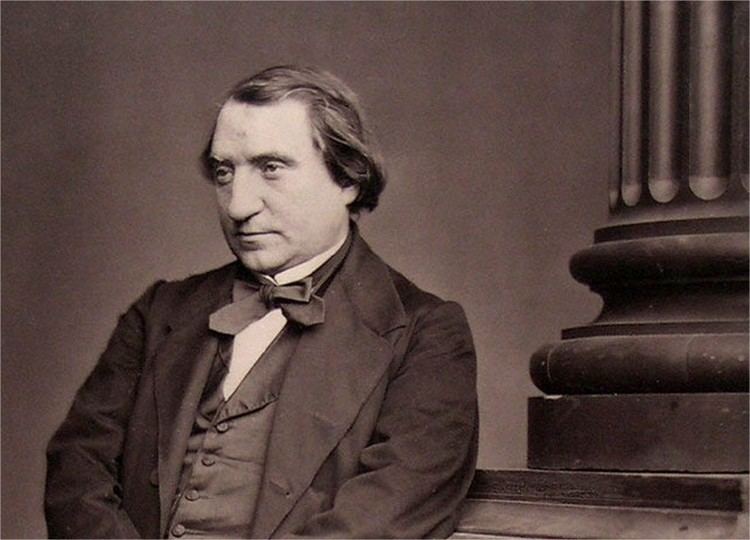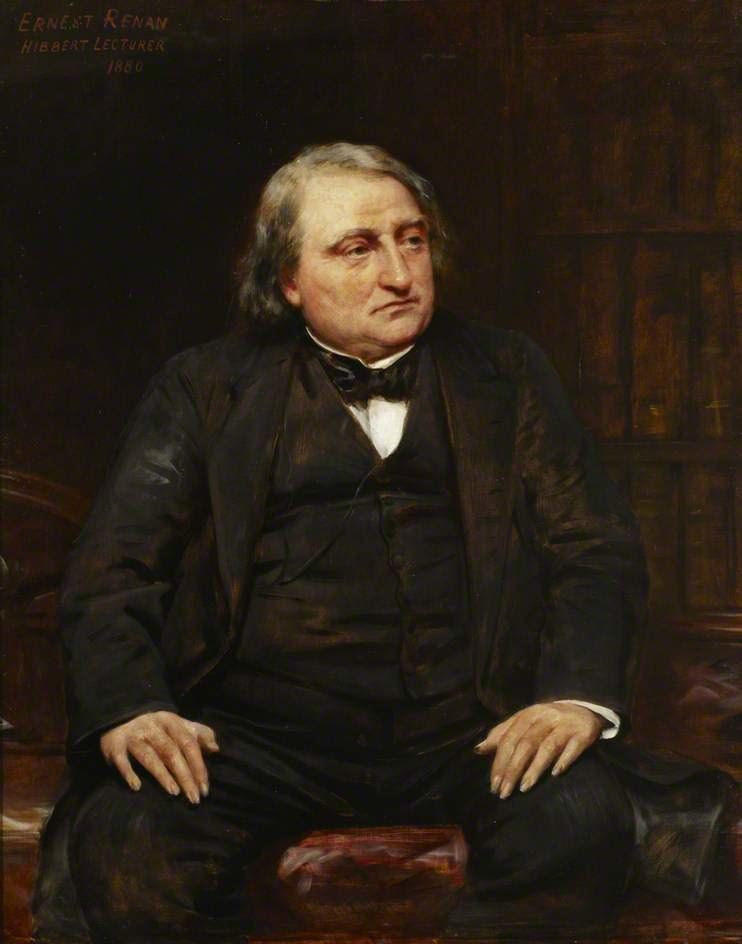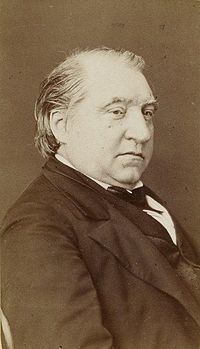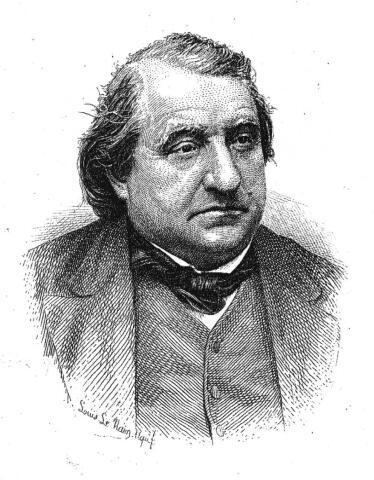Region Western Philosophy Name Ernest Renan | Role Philosopher Children Ary Renan | |
 | ||
Full Name Joseph Ernest Renan Parents Magdelaine Feger, Philibert Renan Books What is a Nation?, The life of Jesus, Renan's life of Jesus, La reforme intellectuelle et morale, Christ in Art Similar People Jamal ad‑Din al‑Afghani, Hippolyte Taine, Francois‑Rene de Chateaubriand, Francois Guizot, Edgar Quinet | ||
Ernest Renan | Wikipedia audio article
Joseph Ernest Renan ([ʁənɑ̃]; 28 February 1823 – 2 October 1892) was a French expert of Semitic languages and civilizations (philology), philosopher, historian, and writer, devoted to his native province of Brittany. He is best known for his influential historical works on Early Christianity, and his political theories, especially concerning nationalism and national identity. Renan is credited as being among the first scholars to advance the Khazar theory, which held that Ashkenazi Jews were descendants of the Khazars, Turkic peoples who had adopted Jewish religion and migrated to Western Europe following the collapse of their khanate.
Contents
- Ernest Renan Wikipedia audio article
- Ernest Renan Quotes
- Birth and family
- Education
- Study at Issy les Moulineaux
- Study at college of St Sulpice
- Scholarly career
- Life of Jesus
- Continuation of scholarly career social views
- Definition of nationhood
- Late scholarly career
- Reputation and controversies
- Statue
- Views on race
- Republican racism
- Honours
- Archives and memorabilia
- References

Ernest Renan Quotes
Birth and family

He was born at Tréguier in Brittany to a family of fishermen. His grandfather, having made a small fortune with his fishing-shack, bought a house at Tréguier and settled there, and his father, captain of a small cutter and an ardent republican, married the daughter of a Royalist tradesman from the neighbouring town of Lannion. All his life, Renan was aware of the conflict between his father's and his mother's political beliefs. He was five years old when his father died, and his sister, Henriette, twelve years his senior, became the moral head of the household. Having in vain attempted to keep a school for girls at Tréguier, she departed and went to Paris as a teacher in a young ladies' boarding-school.
Education

Ernest, meanwhile, was educated in the ecclesiastical seminary of his native town. His school reports describe him as "docile, patient, diligent, painstaking, thorough". While the priests taught him mathematics and Latin, his mother completed his education. Renan's mother was half Breton. Her paternal ancestors came from Bordeaux, and Renan used to say that in his own nature the Gascon and the Breton were constantly at odds.

During the summer of 1838, Renan won all the prizes at the college of Tréguier. His sister told the doctor of the school in Paris where she taught about her brother, and he informed F.A.P. Dupanloup, who was involved in organizing the ecclesiastical college of St Nicholas du Chardonnet, a school in which the young Catholic nobility and the most talented pupils of the Catholic seminaries were to be educated together, with the idea of creating friendships between the aristocracy and the priesthood. Dupanloup sent for Renan, who was only fifteen years old and had never been outside Brittany. "I learned with stupor that knowledge was not a privilege of the church ... I awoke to the meaning of the words talent, fame, celebrity." Religion seemed to him wholly different in Tréguier and in Paris. The superficial, brilliant, pseudo-scientific Catholicism of the capital did not satisfy Renan, who had accepted the austere faith of his Breton masters.
Study at Issy-les Moulineaux

In 1840, Renan left St Nicholas to study philosophy at the seminary of Issy-les-Moulineaux. He entered with a passion for Catholic scholasticism. The rhetoric of St Nicholas had wearied him, and his serious intelligence hoped to satisfy itself with the vast and solid material of Catholic theology. Thomas Reid and Nicolas Malebranche first attracted him among the philosophers, and, after these, he turned to G.W.F. Hegel, Immanuel Kant and J.G. Herder. Renan began to see an essential contradiction between the metaphysics which he studied and the faith he professed, but an appetite for truths that can be verified restrained his scepticism. "Philosophy excites and only half satisfies the appetite for truth; I am eager for mathematics", he wrote to Henriette. Henriette had accepted in the family of Count Zamoyski an engagement more lucrative than her former job. She exercised the strongest influence over her brother.
Study at college of St Sulpice
It was not mathematics but philology which was to settle Renan's gathering doubts. His course completed at Issy, he entered the college of St Sulpice in order to take his degree in philology prior to entering the church, and, here, he began the study of Hebrew. He realized that the second part of the Book of Isaiah differs from the first not only in style but in date, that the grammar and the history of the Pentateuch are later than the time of Moses, and that the Book of Daniel is clearly written centuries after the time in which it is set. Secretly, Renan felt himself denied the communion of saints, yet desired to live the life of a Catholic priest. The struggle between vocation and conviction was won by conviction. In October 1845, Renan left St Sulpice for Stanislas, a lay college of the Oratorians. Still feeling too much under the domination of the church, he reluctantly ended the last of his associations with religious life and entered M. Crouzet's school for boys as a teacher.
Scholarly career
Renan, educated by priests, was to accept the scientific ideal with an extraordinary expansion of all his faculties. He became ravished by the splendor of the cosmos. At the end of his life, he wrote of Amiel, "The man who has time to keep a private diary has never understood the immensity of the universe." The certitudes of physical and natural science were revealed to Renan in 1846 by the chemist Marcellin Berthelot, then a boy of eighteen, his pupil at M. Crouzet's school. To the day of Renan's death, their friendship continued. Renan was occupied as usher only during evenings. During the daytime, he continued his researches in Semitic philology. In 1847, he obtained the Volney prize, one of the principal distinctions awarded by the Academy of Inscriptions, for the manuscript of his "General History of Semitic Languages." In 1847, he took his degree as Agrégé de Philosophie – that is to say, fellow of the university – and was offered a job as master in the lycée Vendôme.
In 1856, Ernest Renan married in Paris Cornélie Scheffer, daughter of Hendrik Scheffer and niece of Ary Scheffer, both French painters of Dutch descent. They had two children, Ary Renan, born in 1858, who became a painter, and Noémi, born in 1862, who eventually married Yannis Psycharis.
Life of Jesus
Within his lifetime, Renan was best known as the author of the enormously popular Life of Jesus (Vie de Jésus, 1863). Renan attributed the idea of the book to his sister, Henriette, with whom he was traveling in Ottoman Syria and Palestine when, struck with a fever, she died suddenly. With only a New Testament and copy of Josephus as references, he began writing. The book was first translated into English in the year of its publication by Charles E. Wilbour and has remained in print for the past 145 years. Renan's Life of Jesus was lavished with ironic praise and criticism by Albert Schweitzer in his book The Quest of the Historical Jesus.
Renan claimed Jesus was able to purify himself of Jewish traits and that Jesus became an Aryan, his Life of Jesus promoted racial ideas and infused race into theology and the person of Jesus, he depicted Jesus as a Galilean who was transformed from a Jew into a Christian, and that Christianity emerged purified of any Jewish influences. The book was based largely on the Gospel of John, and was a scholarly work. It depicted Jesus as a man but not God, and rejected the miracles of the Gospel. Renan believed by humanizing Jesus he was restoring to him a greater dignity. The book's controversial assertions that the life of Jesus should be written like the life of any historic person, and that the Bible could and should be subject to the same critical scrutiny as other historical documents caused some controversy and enraged many Christians, and many Jews were enraged because of its depiction of Judaism as foolish and absurdly illogical and for insisting that Jesus and Christianity was superior.
Continuation of scholarly career: social views
Renan was not only a scholar. In his book on St. Paul, as in the Apostles, he shows his concern with the larger social life, his sense of fraternity, and a revival of the democratic sentiment which had inspired L'Avenir de la Science. In 1869, he presented himself as the candidate of the liberal opposition at the parliamentary election for Meaux. While his temper had become less aristocratic, his liberalism had grown more tolerant. On the eve of its dissolution, Renan was half prepared to accept the Empire, and, had he been elected to the Chamber of Deputies, he would have joined the group of l'Empire liberal, but he was not elected. A year later, war was declared with Germany; the Empire was abolished, and Napoleon III became an exile. The Franco-Prussian War was a turning-point in Renan's history. Germany had always been to him the asylum of thought and disinterested science. Now, he saw the land of his ideal destroy and ruin the land of his birth; he beheld the German no longer as a priest, but as an invader.
In La Réforme Intellectuelle et Morale (1871), Renan tried to safeguard France's future. Yet, he was still influenced by Germany. The ideal and the discipline which he proposed to his defeated country were those of her conqueror—a feudal society, a monarchical government, an elite which the rest of the nation exists merely to support and nourish; an ideal of honor and duty imposed by a chosen few on the recalcitrant and subject multitude. The errors attributed to the Commune confirmed Renan in this reaction. At the same time, the irony always perceptible in his work grows more bitter. His Dialogues Philosophiques, written in 1871, his Ecclesiastes (1882) and his Antichrist (1876) (the fourth volume of the Origins of Christianity, dealing with the reign of Nero) are incomparable in their literary genius, but they are examples of a disenchanted and sceptical temper. He had vainly tried to make his country obey his precepts. The progress of events showed him, on the contrary, a France which, every day, left a little stronger, and he roused himself from his disbelieving, disillusioned mood and observed with interest the struggle for justice and liberty of a democratic society. The fifth and sixth volumes of the Origins of Christianity (the Christian Church and Marcus Aurelius) show him reconciled with democracy, confident in the gradual ascent of man, aware that the greatest catastrophes do not really interrupt the sure if imperceptible progress of the world and reconciled, also, if not with the truths, at least with the moral beauties of Catholicism and with the remembrance of his pious youth.
Definition of nationhood
Renan's definition of a nation has been extremely influential. This was given in his 1882 discourse Qu'est-ce qu'une nation? ("What is a Nation?"). Whereas German writers like Fichte had defined the nation by objective criteria such as a race or an ethnic group "sharing common characteristics" (language, etc.), Renan defined it by the desire of a people to live together, which he summarized by a famous phrase, "avoir fait de grandes choses ensemble, vouloir en faire encore" (having done great things together and wishing to do more). Writing in the midst of the dispute concerning the Alsace-Lorraine region, he declared that the existence of a nation was based on a "daily plebiscite." Some authors criticize that definition, based on a "daily plebiscite", because of the ambiguity of the concept. They argue that this definition is an idealization and it should be interpreted within the German tradition and not in opposition to it. They say that the arguments used by Renan at the conference What is a Nation? are not consistent with his thinking.
Karl Deutsch (in "Nationalism and its alternatives") suggested that a nation is "a group of people united by a mistaken view about the past and a hatred of their neighbors." This phrase is frequently, but mistakenly, attributed to Renan himself. He did indeed write that if "the essential element of a nation is that all its individuals must have many things in common", they "must also have forgotten many things. Every French citizen must have forgotten the night of St. Bartholomew and the massacres in the 13th century in the South." Renan's work has especially influenced 20th century theorist of nationalism, Benedict Anderson.
Late scholarly career
As he got older, the philosopher contemplated his childhood. He was nearly sixty when, in 1883, he published the autobiographical Souvenirs d'Enfance et de Jeunesse, the work by which he is now best known in France.
They showed the blasé modern reader that a world no less poetic, no less primitive than that of the Origins of Christianity exists or still existed within living memory on the northwestern coast of France. They have the Celtic magic of ancient romance and the simplicity, the naturalness, and the veracity which the 19th century prized so highly. But his Ecclesiastes, published a few months earlier, his Drames Philosophiques, collected in 1888, give a more adequate image of his fastidious critical, disenchanted, yet optimistic spirit. They show the attitude towards uncultured Socialism of a philosopher liberal by conviction, by temperament an aristocrat. We learn in them how Caliban (democracy), the mindless brute, educated to his own responsibility, makes after all an adequate ruler; how Prospero (the aristocratic principle, or, if we will, the mind) accepts his dethronement for the sake of greater liberty in the intellectual world, since Caliban proves an effective policeman and leaves his superiors a free hand in the laboratory; how Ariel (the religious principle) acquires a firmer hold on life and no longer gives up the ghost at the faintest hint of change. Indeed, Ariel flourishes in the service of Prospero under the external government of the many-headed brute. Religion and knowledge are as imperishable as the world they dignify. Thus, out of the depths rises unvanquished the essential idealism of Renan.
Renan was a great worker. At sixty years of age, having finished the Origins of Christianity, he began his History of Israel, based on a lifelong study of the Old Testament and on the Corpus Inscriptionum Semiticarum, published by the Académie des Inscriptions under Renan's direction from the year 1881 till the end of his life. The first volume of the History of Israel appeared in 1887; the third, in 1891; the last two posthumously. As a history of facts and theories, the book has many faults; as an essay on the evolution of the religious idea, it is (despite some passages of frivolity, irony, or incoherence) of extraordinary importance; as a reflection of the mind of Renan, it is the most lifelike of images. In a volume of collected essays, Feuilles Détachées, published also in 1891, we find the same mental attitude, an affirmation of the necessity of piety independent of dogma. During his last years, he received many honors, and was made an administrator of the Collège de France and grand officer of the Legion of Honor. Two volumes of the History of Israel, his correspondence with his sister Henriette, his Letters to M. Berthelot, and the History of the Religious Policy of Philippe-le-Bel, which he wrote in the years immediately before his marriage, all appeared during the last eight years of the 19th century.
Renan died after a few days' illness in 1892 in Paris, and was buried in the Cimetière de Montmartre in the Montmartre Quarter.
Reputation and controversies
Hugely influential in his lifetime, Renan was eulogised after his death as the embodiment of the progressive spirit in western culture. Anatole France wrote that Renan was the incarnation of modernity. One of his greatest admirers was Manuel González Prada in Peru who took the Life of Jesus as a basis for his anticlericalism. In his 1932 document "The Doctrine of Fascism", Italian dictator Benito Mussolini also applauded perceived "prefascist intuitions" in a section of Renan's "Meditations" that argued against democracy and individual rights as "chimerical" and intrinsically opposed to "nature's plans".
Statue
In 1903 a major controversy accompanied the installation of a monument in Tréguier designed by Jean Boucher. Placed in the local cathedral square, it was interpreted as a challenge to Catholicism, and led to widespread protests, especially because the site was normally used for the temporary pulpit erected at the traditional Catholic festival of the Pardon of St Yves. It also included the Greek goddess Athena raising her arm to crown Renan gesturing in apparent challenge towards the cathedral. The local clergy organised a protest Calvary sculpture designed by Yves Hernot as "a symbol of the triumphant ultramontaine church."
Views on race
Renan believed that racial characteristics were instinctual and deterministic. He has been criticised for his antisemitic claims that the Semitic race is inferior to the Aryan race. Renan claimed that the Semitic mind was limited by dogmatism and lacked a cosmopolitan conception of civilisation. For Renan, Semites were "an incomplete race." Some authors argue that Renan developed his antisemitism from Voltaire's anti-Judaism.
However, he did not regard the Ashkenazi Jews of Europe as being a Semitic people; Renan is credited with launching the so-called Khazar theory. This theory states that Ashkenazim had their origin in Turkic refugees that had converted to Judaism and later migrated from the collapsed Khazar Khanate westward into the Rhineland, and exchanged their native Khazar language for the Yiddish language while continuing to practice the Jewish religion. In his 1883 lecture "Le Judaïsme comme race et comme Religion" he disputed the concept that Jewish people constitute a unified racial entity in a biological sense, which made his views unpalatable within racial antisemitism. Renan was also known for being a strong critic of German ethnic nationalism, with its antisemitic undertones. His notions of race and ethnicity were completely at odds with the European antisemitism of the 19th and 20th centuries.
Renan wrote the following about the long history of persecution of Jews:
When all nations and all ages have persecuted you, there must be some motive behind it all. The Jew, up to our own time, insinuated himself everywhere, claiming the protection of the common law; but, in reality, remaining outside the common law. He retained his own status; he wished to have the same guarantees as everyone else, and, over and above that, his own exceptions and special laws. He desired the advantages of the nations without being a nation, without helping to bear the burdens of the nations. No people has ever been able to tolerate this. The nations are military creations founded and maintained by the sword; they are the work of peasants and soldiers; towards establishing them the Jews have contributed nothing. Herein is the great fallacy inspired in Israelite pretensions. The tolerated alien can be useful to a country, but only on condition that the country does not allow itself to be invaded by him. It is not fair to claim family rights in a house which one has not built, like those birds which come and take up their quarters in a nest which does not belong to them, or like the crustaceans which steal the shell of another species.
Other comments on race, have also proven controversial, especially his belief that political policy should take into account supposed racial differences:
Nature has made a race of workers, the Chinese race, who have wonderful manual dexterity and almost no sense of honor... A race of tillers of the soil, the Negro; treat him with kindness and humanity, and all will be as it should; a race of masters and soldiers, the European race. Reduce this noble race to working in the ergastulum like Negroes and Chinese, and they rebel... But the life at which our workers rebel would make a Chinese or a fellah happy, as they are not military creatures in the least. Let each one do what he is made for, and all will be well.
This passage, among others, was cited by Aimé Césaire in his Discourse on Colonialism, as evidence of the alleged hypocrisy of Western humanism and its "sordidly racist" conception of the rights of man.
Republican racism
During the arising of racism theories around Europe and specifically in France—French Republic (1870–1940)—Renan had an important influence on the matter. He was a defender of people's self-determination concept, but on the other hand was in fact convinced of a "racial hierarchy of peoples" that he said was "established". Discursively, he subordinated the principle of self-determination of peoples to a racial hierarchy, i.e. he supported the colonialist expansion and the racist view of the Third Republic because he believed the French to be hierarchically superior (in a racial matter) to the African nations. This subtle racism, called by Gilles Manceron "Republican racism" was common in France during the Third Republic, and was also a well-known defensing discourse in politics. Supporters of colonialism used the concept of cultural superiority, and described themselves as "protectors of civilization" to justify their colonial actions and territorial expansion.
